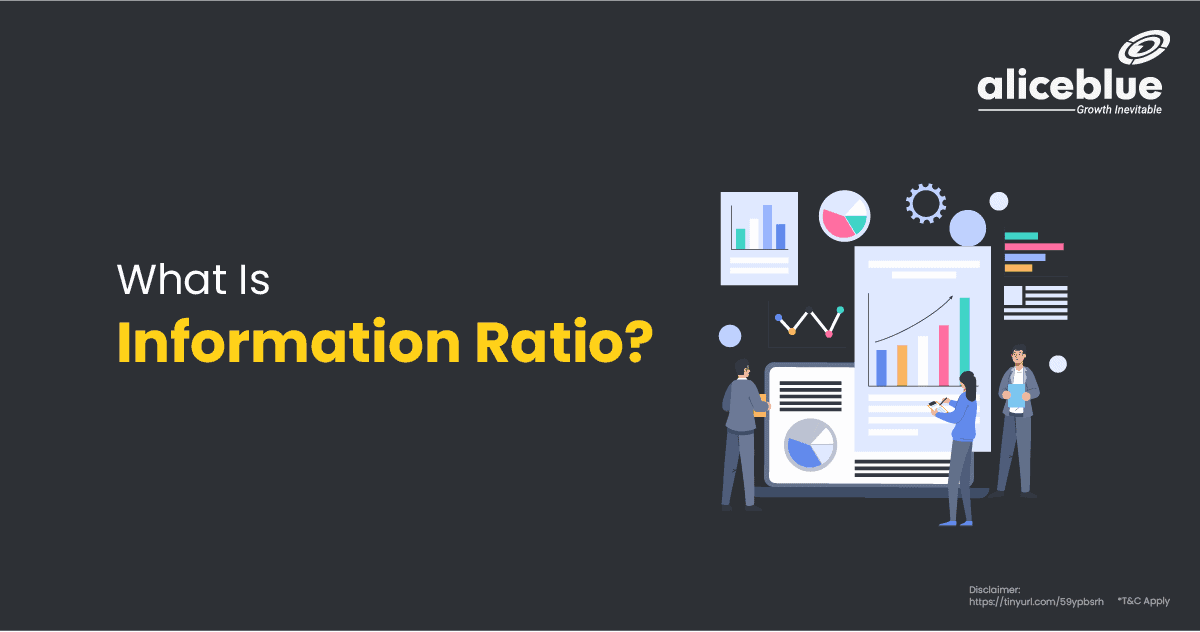The Information Ratio measures a portfolio manager’s ability to generate excess returns above a benchmark, relative to the volatility of those returns. It’s a key performance indicator, highlighting the consistency and effectiveness of a manager in surpassing the market index.
Content:
- Information Ratio Meaning
- Information Ratio Example
- How To Calculate The Information Ratio? – Information Ratio Formula
- Information Ratio Vs Sharpe Ratio
- How is the Information Ratio Useful?
- Limitations of Information Ratio
- Information Ratio Meaning – Quick Summary
- Information Ratio – FAQs
Information Ratio Meaning
The Information Ratio is a financial metric used to assess a portfolio manager’s skill in generating excess returns above a benchmark, relative to the risk taken. It compares the manager’s performance to the market index, factoring in the volatility of the excess returns.
This ratio is crucial for evaluating the consistency and efficiency of a fund manager. A higher Information Ratio indicates a manager’s superior ability to deliver additional returns while effectively managing risk. It’s particularly useful for comparing the performance of managers with similar investment strategies.
Investors use the Information Ratio to identify funds with consistent, risk-adjusted outperformance. It helps in distinguishing between returns achieved through skill versus luck. However, it’s essential to consider it alongside other metrics for a comprehensive understanding of a fund’s performance.

Information Ratio Example
An Information Ratio (IR) example involves a fund manager whose portfolio returns 15% against a 10% benchmark return, with a tracking error (volatility of excess returns) of 5%. The IR, calculated as the excess return over the tracking error, would be 1.0 in this case.
The Information Ratio quantifies how much additional return the manager generates for each unit of risk. In the example, an IR of 1.0 signifies that the manager achieves an excess return of 1% for every 1% of additional risk taken over the benchmark.
This ratio helps investors gauge a manager’s skill in outperforming the market, adjusted for risk. A high IR indicates effective risk management and skillful performance, making it a valuable tool for comparing and selecting fund managers or investment strategies.
How To Calculate The Information Ratio? – Information Ratio Formula
To calculate the Information Ratio (IR), divide the difference between the portfolio’s return and the benchmark return (excess return) by the tracking error, which is the standard deviation of the excess return.
The formula is IR = (Portfolio Return – Benchmark Return) / Tracking Error.
This calculation assesses a manager’s ability to generate extra returns over a benchmark, relative to the risk taken. A high IR indicates efficient performance with respect to risk. The numerator highlights skill in overperforming the benchmark, while the denominator measures risk consistency.
Understanding the IR is essential for investors to evaluate fund managers. A positive IR suggests outperformance relative to the risk, whereas a negative IR indicates underperformance. This ratio helps in making informed decisions, especially when comparing funds with similar objectives.
Information Ratio Vs Sharpe Ratio
The main difference between the Information Ratio and the Sharpe Ratio is that the Information Ratio measures excess returns over a benchmark relative to tracking error, while the Sharpe Ratio evaluates the overall risk-adjusted returns of a portfolio compared to a risk-free asset.
| Feature | Information Ratio | Sharpe Ratio |
| Purpose | Measures excess returns over a benchmark | Assesses overall risk-adjusted returns |
| Relative To | Benchmark (e.g., a market index) | Risk-free rate (e.g., Treasury Bills) |
| Denominator (Risk) | Tracking error (standard deviation of excess returns) | The standard deviation of portfolio returns |
| Indication of | Manager’s skill in beating the benchmark | Overall investment efficiency |
| Useful For | Comparing fund managers against a specific benchmark | Evaluating standalone investment performance |
| Implication of High-Value | Superior risk-adjusted returns over benchmark | Superior risk-adjusted returns in general |
How is the Information Ratio Useful?
The main uses of the Information Ratio are to evaluate a portfolio manager’s skill in generating excess returns over a benchmark, gauge the consistency and efficiency of these returns, and compare the performance of managers with similar strategies, emphasizing risk-adjusted outperformance.
- Skill Assessment Powerhouse
The Information Ratio shines as a tool for assessing a portfolio manager’s proficiency. By focusing on excess returns over a benchmark, it differentiates skill from luck, revealing a manager’s ability to consistently outperform the market while taking into account the risk involved.
- Risk-Adjusted Performance Spotlight
This ratio highlights not just the returns but how those returns are achieved. It emphasizes the efficiency of risk-taking, showcasing managers who deliver more bang for each unit of risk, thus offering a comprehensive view of both return and risk management.
- Benchmark Brawler
In an environment with numerous investment strategies, the Information Ratio is invaluable for comparing fund managers against a specific benchmark. This focused comparison makes it easier for investors to choose a manager whose strategy aligns well with their investment objectives and risk tolerance.
- Consistency Checker
The Information Ratio is not just about one-time success; it’s about consistent performance. It helps investors and analysts to track a fund’s ability to maintain its edge over the market, thus providing a more reliable basis for long-term investment decisions.
- Strategy Selector
For investors looking at various funds with similar strategies, this ratio becomes a crucial deciding factor. It aids in identifying funds that not only perform well but do so in a risk-efficient manner, enabling investors to make more informed choices that align with their risk appetite.
Limitations of Information Ratio
The main limitations of the Information Ratio include its reliance on historical data, which may not predict future performance, and its sensitivity to the chosen benchmark, where an inappropriate benchmark can skew results. Additionally, it overlooks the absolute level of returns and risks involved.
- Historical Data Hangover
The Information Ratio depends heavily on past performance data, implying a major limitation. Past success doesn’t guarantee future results, and this backward-looking focus can be misleading, especially in rapidly changing markets where historical patterns may not repeat.
- Benchmark Blues
Choosing the right benchmark is crucial for the Information Ratio’s effectiveness. An inappropriate or misaligned benchmark can lead to distorted insights, making the ratio less reliable. This dependency on the benchmark’s relevance can significantly affect the accuracy of assessing a manager’s performance.
- Absolute Return Aversion
The Information Ratio pays little attention to the absolute level of returns or risks. It’s possible for a fund to have a high ratio by slightly outperforming a low-return benchmark, which might not be attractive to investors seeking higher absolute returns.
- Short-term Sharpened
This ratio is more sensitive to short-term performance fluctuations. It can overemphasize recent successes or failures, potentially obscuring a fund manager’s long-term effectiveness and leading to rash judgments based on short-term observations.
- Overshadowing Other Risks
While focusing on the tracking error, the Information Ratio might overshadow other types of risks, such as liquidity risk or sector-specific risks. This singular focus could give a partial view, missing out on a holistic risk assessment of the investment.
Information Ratio Meaning – Quick Summary
- The Information Ratio evaluates a portfolio manager’s skill in outperforming a benchmark relative to risk, measuring excess returns against market index volatility.
- The Information Ratio (IR) is calculated by dividing a portfolio’s excess return over its benchmark by the tracking error, the standard deviation of this excess. The formula is IR = (Portfolio Return – Benchmark Return) / Tracking Error.
- The main distinction between the Information Ratio and the Sharpe Ratio lies in the Information Ratio assessing excess returns over a benchmark against tracking error, and the Sharpe Ratio evaluating a portfolio’s overall risk-adjusted returns in comparison to a risk-free asset.
- The main function of the Information Ratio is to assess a portfolio manager’s skill in outperforming a benchmark, ensuring consistency and efficiency in returns, and to compare managers with similar strategies, focusing on risk-adjusted performance.
- The main drawbacks of the Information Ratio are its dependency on historical data, not indicative of future results, sensitivity to benchmark selection, potentially leading to skewed outcomes, and its disregard for the absolute level of returns and risks.
- Open free demat account with Alice Blue in 15 minutes today! Invest in Stocks, Mutual Funds, Bonds & IPOs for Free. Also, trade at just ₹ 15/order and save 33.33% brokerage on every order.

Information Ratio – FAQs
1. What Is the Information Ratio In Mutual Fund?
Information Ratio in mutual funds measures a fund’s ability to generate excess returns relative to a benchmark, adjusted for risk. It evaluates the manager’s skill in utilizing information for superior performance.
2. What Is An Example Of Information Ratio?
An example of an Information Ratio: A mutual fund outperforms its benchmark by 5% annually with a tracking error of 3%. Its Information Ratio would be 1.67, indicating superior risk-adjusted returns.
3. What Is A Good Information Ratio Level?
A good Information Ratio level varies depending on the investment strategy and market conditions. Generally, ratios above 0.5 are considered favorable, but higher values, such as 1 or greater, indicate superior risk-adjusted performance.
4. What Is The Difference Between the Sharpe Ratio And Information Ratio?
The main difference between the Sharpe Ratio and Information Ratio is that the Sharpe Ratio measures risk-adjusted returns relative to total risk, while the Information Ratio assesses excess returns relative to benchmark risk.
5. What Is The Formula For Information Ratio?
The formula for the Information Ratio is:
Information Ratio = (Portfolio Return – Benchmark Return) / Tracking Error,
where Portfolio Return is the return of the fund, Benchmark Return is the return of the benchmark index, and Tracking Error measures volatility.
We hope that you are clear about the topic. But there is more to learn and explore when it comes to the stock market, commodity and hence we bring you the important topics and areas that you should know:






